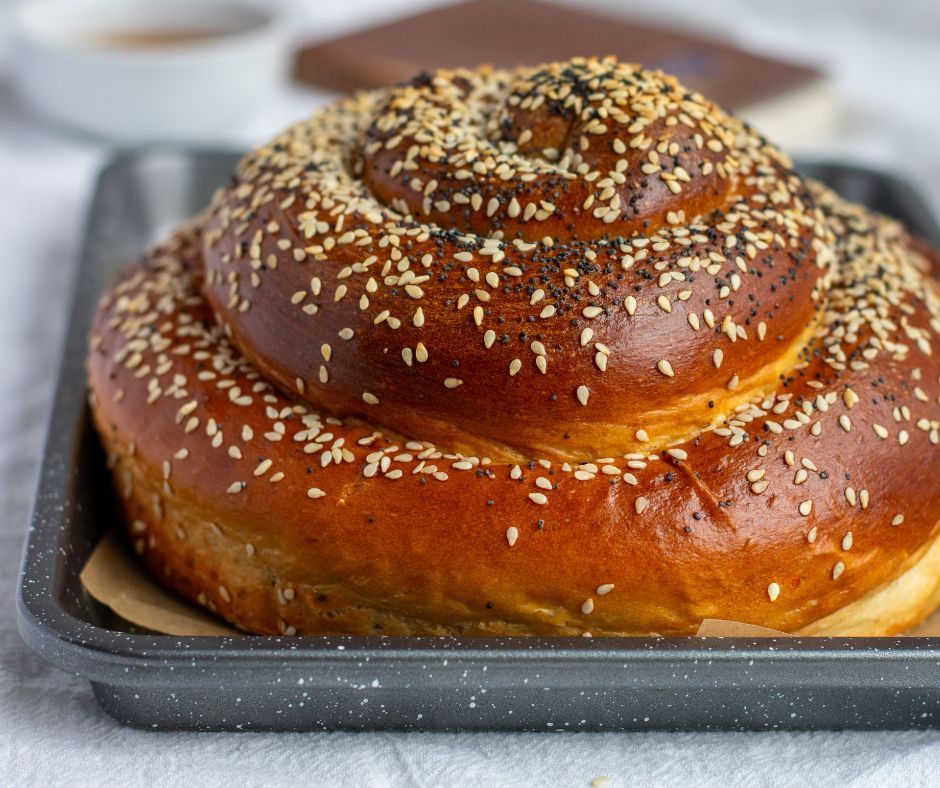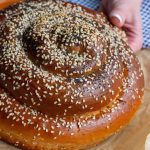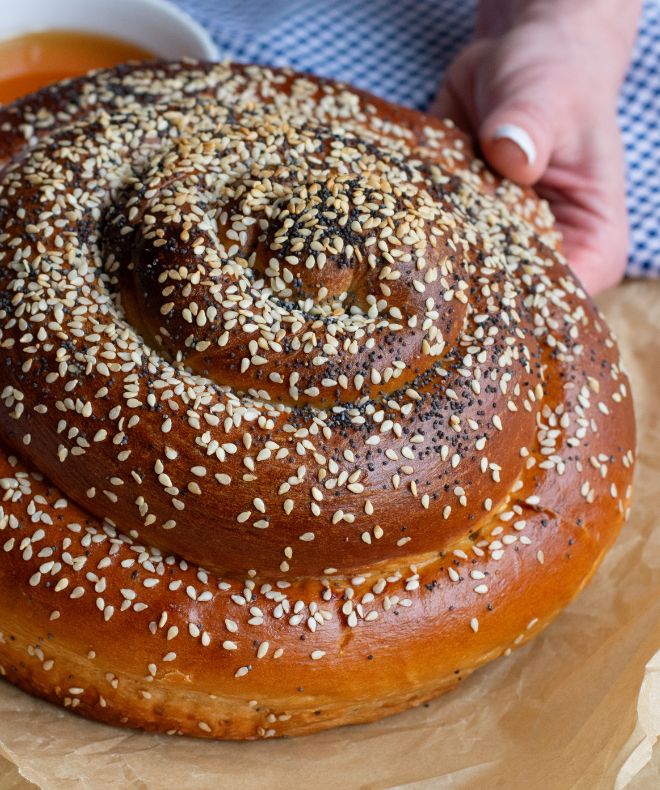Round Challah is Also Known As Turban Challah or Spiral Challah
Challah is the most iconic and uniquely Jewish food. It is a rich braided bread served on Shabbat and holidays. Similar to brioche, the bread is slightly sweet and wonderfully soft inside.
Rosh Hashanah, the Jewish New Year, is a time to reflect on the past year- and look forward to the coming one. Celebrating Rosh Hashanah is all about tradition. The holiday festive meal festive meal can include favorites like matzo ball soup, tzimmes, honey cake, and Challah.
Try making a Round Challah for your next Rosh Hashanah celebration and enjoy the delicious taste and symbolic meaning of this special bread.
For my “The Complete Challah Guide” FREE ebook, join my mailing list here.
If you like Challah, try my Spelt Challah, Sweet Challah Bread, or Vegan Challah.

Why Do We Make Round Challah for Rosh Hashanah?
The round Challahs have no end, symbolizing (and actualizing) the wish for a year in which life and blessings continue without end.
Ingredients Overview
*The full recipe is in the recipe card below!
Before you start baking using this Challah Recipe, measure and prepare your ingredients so the cooking process will go smoothly and easily.
All-purpose flour: I use all-purpose flour, but you could use bread flour or a combination of bread and all-purpose. Remember that bread flour has a higher protein content and will give your bread more structure. I strongly recommend sifting the flour; it will result in a more delicate dough with a more significant volume.
Water: It’s best to use water between 100°F and 110°F (38°C- 43°C); it helps to activate the yeast. If you don’t have a thermometer, don’t overthink the water temperature. You want the water warm. Not hot. Not cold. Not freezing. Just warm. The proportion of water in bread dough corresponds to how hydrated, or wet, it is.
Yeast (active dry yeast): Active dry yeast needs to be bloomed in liquid before being used to make dough. However, it is not necessary to bloom newly purchased yeast. Instead, they can be added directly to the dry ingredients.
Oil: Canola, vegetable, or Avocado oil can also work here.
Sugar and salt: Flavor.
How to Shape a Round Challah?
Instead of braiding ropes of dough, you roll out one long rope, then spiral it around itself until you reach the end. Make sure to pinch the end of the spiral and tuck it under the loaf.
Pro-Tips
Weigh all your ingredients and get everything in order so you can follow the recipe exactly.
Mixing the dough: Scrap the sides of the bowl occasionally with a rubber spatula to ensure all ingredients are incorporated.
Water: Because each flour is different, stored differently, and has different absorption capacities, the amount of liquid will almost always change. Even if you always use the same flour, it may be that the flour will absorb more liquid on different days. So, start with half a cup of water and gradually add as needed. The dough should be very soft but not sticky. Dough lacking in liquid will be stiffer and less comfortable to work with.
Checking the dough internal temperature: In the oven, due to its distinctive shape, the outer layer of the dough tends to brown rapidly, potentially giving a misleading impression of doneness. Relying solely on visual cues may result in an under-cooked interior. Therefore, the internal temperature serves as a more precise and reliable indicator of the bread’s readiness. This practice ensures that the Challah is thoroughly baked. The internal temperature should be in the range of 190-210°F (87-99°C).
FAQ’S
Absolutely! Challah freezes very well.
If you are going to freeze your bread, do so on the first day when it is fresh. This way, you will lock in all that moisture. Do not wait 2-3 days and then freeze it, as your bread would have already lost moisture.
For freezing, I recommend completely cooling the Challah. Once completely cooled, place your Challah directly in a heavy-duty, thick freezer bag or wrap it tightly with a saran wrap.
To defrost, remove your Challah from the freezer about 5-7 hours before it will be served (leave it wrapped), and let it come to room temperature.
Remove the plastic wrap and lay the defrosted loaf on a baking sheet for those who like warm Challah. Set the oven to 350 degrees F° (180 C°) and bake for about 10 minutes.
Yes! If you double the dough, you can make two large loaves or three medium-sized loaves.
More Recipes You’ll Love

Round Challah
Description
Equipment
- Rolling pin optional
- Instant read food thermometer highly recommended
Ingredients
- 3 and 1/2 cups (500g) sifted all-purpose flour plus a little more for dusting I strongly recommend sifting the flour; it will result in a more delicate dough with a more significant volume.
- 1 Tablespoon (10g) active dry yeast
- 1/4 cup (60ml) canola oil plus a little more for greasing
- 3 Tablespoons (30g) granulated sugar or 3 tablespoons of honey
- 1 and 1/4 to 1 and 1/2 cups (300-350ml) lukewarm water you want the water warm. Not hot. Not cold. Not freezing. Just warm.
- 1/2 Teaspoon salt
For brushing:
- 1 egg
- 1 Tablespoon (15ml) olive oil
- 1 Tablespoon (10g) granulated sugar
For brushing- vegan:
- 2 Tablespoons (30ml) real maple syrup
- 1 Tablespoon (15ml) olive oil
Optional for garnish
- 2 Tablespoons sesame seeds or poppy seeds
Instructions
- Put flour and yeast in the bowl of a standing mixer (or in a large mixing bowl if kneading by hand) and mix/stir on a low speed for one minute.
- Add oil and sugar and mix for about one minute.
- While the mixer is working, slowly add water and mix to form the dough.*Because each flour is different, stored differently, and has different absorption capacities, the amount of liquid will almost always change. Even if you always use the same flour, it may be that on different days, the flour will absorb more liquid than before. So, start with half a cup of water and gradually add enough until the dough is soft but not sticky. Dough that lacks liquid will be stiffer and much less comfortable to work with. The water temperature should be warm.
- Add the salt and knead the dough for 10-15 minutes (It helps the gluten form and the dough to be elastic with better structure).
- Grease the dough with a little bit of oil, cover with a kitchen towel or loosely with saran wrap and let the dough rise until doubled (place the bowl somewhere warm). It takes between 1-3 hours at room temperature.
- Roll the dough into a long rope. If the dough is sticky, add a *little bit* of flour. When making Challah, less is more!
- Spiral it around itself until you reach the end. Tuck the end under the bread.
- Line a baking sheet with parchment paper and place the Challah on it.
- Place the pan somewhere warm, cover with a towel, and let it rise until puffed, about an hour.
- Heat the oven to 400°F/200°C.
- Whisk the topping ingredients and, when ready to bake and brush it all over the Challah.
- Sprinkle on sesame seeds.
- Slide the Challah on its baking sheet into the oven and bake for 30 to 40 minutes. The Challah is done when it is a rich golden brown and registers 190°F/90°C in the very middle with an instant-read thermometer. If the crust is browning too rapidly, you can tent the Challah with aluminum foil. This will shield the outer layer from direct heat and slow down the browning process, giving the interior more time to cook.
- Let the Challah cool on a cooling rack.
Notes
- If your Challah is browning too quickly while baking: Tent the Challah with aluminum foil. Place the foil gently over the challah, making sure it doesn’t stick to the dough.
- Checking the dough internal temperature: In the oven, due to its distinctive shape, the outer layer of the dough tends to brown rapidly, potentially giving a misleading impression of doneness. Relying solely on visual cues may result in an undercooked interior. Therefore, the internal temperature serves as a more precise and reliable indicator of the bread’s readiness. This practice ensures that the Challah is thoroughly baked. The internal temperature should be in the range of 190-210°F (87-99°C).
- Mixing the dough: Scrap the sides of the bowl occasionally with a rubber spatula to ensure all ingredients are incorporated.
- Water: Because each flour is different, stored differently, and has different absorption capacities, the amount of liquid will almost always change. Even if you always use the same flour, it may be that the flour will absorb more liquid on different days. So, start with half a cup of water and add as needed gradually. The dough should be very soft but not sticky. Dough lacking in liquid will be stiffer and less comfortable to work with.


Great
Hello! I noticed that you don’t have an egg listed in the recipe for your challah. Is that an oversight or you don’t use eggs in your challah? Thank you so much for your recipes! I’m excited to make some of these special recipes!
You are correct! No eggs in this recipe!
Thank you so much for trying my recipes
Great recipe thank you
Turned out great
thank you
Great recipe!
Love it
thank you
so pretty
thank you
Great recipe
great recipe